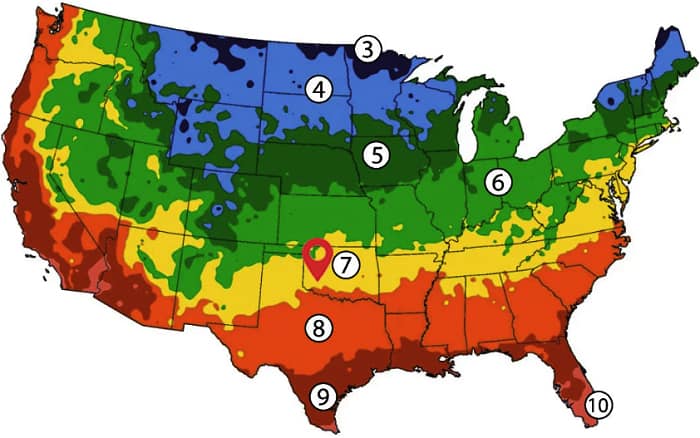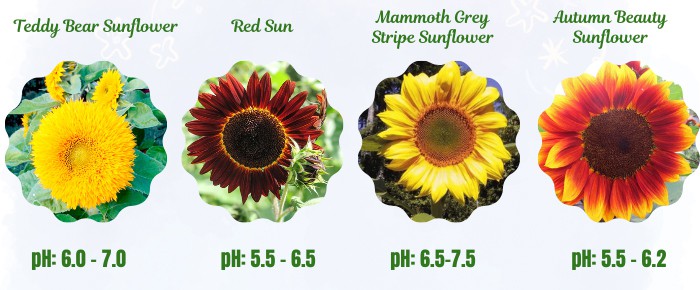Sunflowers are one of the most popular blooms because of their aesthetic charm, beneficial uses and how easy they are to grow. What time of year you should plant sunflower seeds depends on your hardiness zone.
So, when to plant sunflowers in Zone 7? is around April 15 to May 15, after the last frost.
There are also other factors involved in proper sunflower plant care. Here is our guide on growing, maintaining, and harvesting high-quality sunflowers.
Table of Contents
When is the Best Time to Plant Sunflowers in Zone 7?
1. About Zone 7
To master growing sunflowers in a Zone 7 area, it’s important first to understand what Zone 7 means.
Zone 7 is one of the 13 hardiness zones outlined by the US Department of Agriculture Plant Hardiness Zone Map. This serves as a guide for gardeners to determine which plants thrive best in certain states and locations.
Each zone also has subzones separated by 5° Fahrenheit increments. Thus its subzones are categorized as Zone 7a and Zone 7b, with rather similar weather conditions.
There are Zone 7 areas across 28 states, including:
Alabama
Nevada
Alaska
New Jersey
Arizona
New Mexico
Arkansas
New York
California
North Carolina
Colorado
Oklahoma
Connecticut
Oregon
Delaware
Pennsylvania
Georgia
Rhode Island
Idaho
South Carolina
Maryland
Tennessee
Massachusetts
Texas
Mississippi
Utah
Missouri
Washington
2. Ideal time for planting sunflowers
Zone 7 gardening is characterized by a medium to moderate growing window. This means you would have fairly ample time to cultivate plants between the last frost date and the first frost date of the next season.
You should only sow sunflower seeds outdoors after the final frost date.
- For Zone 7, the best time for sowing sunflower seeds in your garden is April 15 – May 15 when the soil temperature is warm, ranging from 50°F (10°C) – 86°F(30°C).
Take note that if you plant your seeds outside too early, they can be hindered by poor germination and slow growth. A hard freeze can also cause your seedlings to die, so make sure you are starting your seeds outdoors at the right time!
Alternatively, you can consider starting flower seeds indoors for a head start. This can be done as early as 4 weeks before the final frost date.
- As such, in Zone 7, you can start your sunflower seeds indoors around the second week of March.
Your plants will be ready to be transplanted outdoors once they start growing 2 to 3 sets of leaves.
Tips for Growing Sunflowers in Zone 7
1. What sunflower varieties to plant in Zone 7?
Most sunflower species are hardy across Zones 2 to 11, giving you various types.
You may consider growing annuals — such as:
- Teddy Bear Sunflower – It requires full exposure to sunlight during growth. The ideal pH level is 6.0 to 7.0, as long as the soil is fertile and well-drained.
- Red Sun – The ideal pH level for the soil to grow this flower is 5.5 – 6.5. It is the perfect choice if you love growing sunflowers in pots. The recommended soil mixture includes perlite, orchid bark, and peat moss.
- Mammoth Grey Stripe Sunflower – You might grow this bright and gorgeous flower in Zone 7 while the soil is as warm as 65˚F – 85˚F.
- Autumn Beauty Sunflower – This type of sunflower will grow well in Zone 7’s summer soil temperature of around 69˚F – 75˚F and pH level of 5.5 – 6.2. Make sure to grow them around April when there is full sun every day, and the soil is moist and fertile.
2. How to care for sunflowers after planting?
Part of the reason why sunflowers are popular among gardeners is because they are easy to care for. Here are some tips to help you properly grow a sunflower garden.
Make sure you plant the flowers 20 cm to 45 cm apart so they have room to grow.
- The ideal soil for sunflowers is well-draining, loose, and organically rich. This type of soil will help with healthy root growth for your sunflowers.
- Also, your sunflowers need deep watering while they are still growing, especially just before and just after they bloom.
- A slow-release granular fertilizer is most advised.
- Some sunflowers can grow very tall and they tend to have larger heads. This makes them prone to bending or breaking. So, stalk your sunflowers with twine or cloth to maintain their stature and prevent flopping.
- If you are growing sunflowers in pots, you need to sow the seeds about 4 to 5 inches apart and half an inch deep. Your soil should be well-moistened, and your container must be kept in a place with lots of sunlight.
3. How to harvest and store sunflowers?
Sunflowers will be ready to harvest after 10 weeks to 11 weeks.
- When harvesting sunflowers for floral use, cut them from the stem before they have opened all the way.
- Harvested sunflowers should be kept in containers with water and indirect sunlight.
- To harvest sunflower seeds, you will have to wait for the sunflower to wilt. You can harvest the seeds by rubbing the bloom until the seeds start to come off. These should be kept in an airtight container and stored in a cool, dry place.
To regrow sunflowers using stored seeds, simply warm the seeds to room temperature until they are ready to be planted once again.
Conclusion
From sowing sunflowers to harvesting their blooms and seeds, cultivating these bright beauties can truly be a rewarding experience. With the right information and ample effort and proper care, your garden can also be brightened up by sunflowers.
As such, we hope this guide answers your question “When to plant sunflowers in Zone 7.” More importantly, we hope this has inspired you to plant your own sunflowers this coming spring!
Read more:

Hi, I am William – Floridayards’ digital content creator. My job is to find answers to all your concerns with thorough research and our team’s expert advice. I will also bring you honest reviews on the best products and equipment for raising your beautiful garden. Please look forward to our work!
















